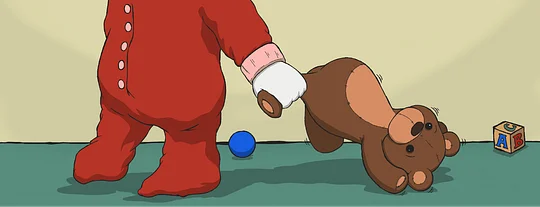From Enemies of Innovation to Patron Saints: A Modern C-Suite Fairy Tale, Complete with Happy Ending

Nobody sets out to block innovation in their organisation. It just happens.
We don’t mean to.
No C-Suite executive starts their day saying ‘today I will frustrate hopes and dreams, make people question their career choices and squander my organisation’s future. Because I can’.
Even the most short-sighted, the most frustratingly risk-averse, not-how-I-was-taught-to-do-things executive never sets out to deprive his organisation of a future. And yet. That is what often happens.
The C-Suite is the enemy of innovation. The stories of great success (from the post-it to Dyson) are either about rebels flaunting rules and flying under the radar until they can reveal fully formed, inexplicable success or people going it alone and striving to realise a vision against all odds and with no support.
Rare are the stories of folks who had an idea, went to their management, got sign-off and went off to change the world. Rare but not impossible. And that’s what this piece is about. A note for the executives that get sucked into the day to day, about the ones who don’t. Because there is a lesson for us all in there somewhere.
Risk, compliance and the curse of the diary
Years and years ago I shadowed the CEO of the Very Large Bank I worked in as part of my personal development.
It was diabolical.
His day was extremely long and terribly fragmented.
A string of half-hour meetings back to back with people for whom this was the most important meeting of the day while he had to be the sage, calm and tireless oracle. Giving the supplicants the attention the occasion demanded. Again and again and again in disconnected, deeply personal and fraught circumstances. Problems, escalations, regulatory issues, clients kicking off, career aspirations frustrated and rivalries. The works.
They all came to the court of the benevolent king, in neat half-hour slots. One after another after another. All needing a fix. None with enough time or context for a wider solution. A ‘let’s get to the heart of this’ approach. And he handled each one as if it was the most important thing. He handled each one with grace and wisdom.
And most of his day passed.
The only real time commitment was made to senior risk committee sessions and other such revelries. Senior working groups wrapped around regulatory compliance or (more commonly) a breach, fail or fear that compliance will not be achieved in a timely manner. Client meetings got squeezed in and on top, usually when escalation was needed. Briefings done in the car or plane.
He was a masterclass in servant leadership. Tireless. Thoughtful. Even-tempered to my insane crankiness by the end of day 1.
When do you get to do any real work?
When do you get to think?
Why can’t you see things before it’s too late?
And of course the painful realisation of oh. Of course, you are not driving innovation. How could you? You firefight 16 hours a day. Something’s gotta give and the undefined cedes its place to the real and present every time.
The hamster wheel is real and if most executives are trapped in it and make the best decisions they can in the circumstances, that does not make them bad people, the inherent villainous enemies of innovation. They are boxed in by the way the business they were asked to run is shaped and too busy to stop and change it.
This is why we can’t have nice things
Christopher Robin walks down the stairs holding Pooh Bear by the foot. With every step Christopher Robin takes, Pooh’s head bangs on the step.
‘There must be a better way to come down the stairs’ thought Pooh. ‘If only my head could stop hurting long enough to think about it’.
There you have it. This is the whole story. The full story.
Innovation in big corporates is thwarted by life in big companies getting in the way of us seeing the big picture. Quarterly results and urgent requests, firefighting and real everyday challenges mean that executives have neither the time, nor the tools, neither the headspace nor the inspiration to think about what comes next and how to position their organisations. This is not new. What is new is how fast what comes next is coming.
Lifting your head from the urgent for the sake of the important
Executives are stuck on their hamster wheel. And HR practices promote and reward exactly the kind of skills and behaviour that will perpetuate this shape. Meanwhile, there is not a single person in the building who doesn’t know change is needed. We know. That doesn’t mean we can do. But we know.
We know the whole organisation needs to change. We know the future demands it. But we do not know what the future looks like so we can’t figure out what those demands are so we don’t know where to start.
We may hire innovation teams and do away days with expensive coaches. We get graffiti artists and throw a few startup events together. But we keep it all at arm’s length, frustrating the teams and wasting their efforts. Not because we are short-sighted. But because we genuinely have nowhere to put these thoughts. No time in the day. No space in the minds of a busy executive. Nothing to benchmark all this against and say: “Yes, this works.”
And unless we know or at least think we know something will work, it is only sensible that we should not commit our people, our organisations, our reputations and your grandmother’s pension to a flight of fancy. Right? Right.
And yet some manage to do it. Not the flight of fancy part. Rather the balancing act between the urgent and the important.
It is no secret I have long been a fan of BBVA’s efforts. The work we are doing with RBS and Mettle, and the journey we have embarked upon with DNB all prove that what I describe here is common but not inevitable. And that should give us all comfort. And a plan of action.
So word to the wise banking exec who wants to get off the hamster wheel and build: it is not going to be you. You will have to carry on doing what you do until the transformation is complete. I know that’s disappointing but it is what it is.
You need to find and promote the guy who you know can imagine this.
Don’t tie his hands. Let him do it. Or her. It’s not about that. I have been ‘the guy’ in this context. Allison Rose is very much the guy in this context.
It’s all about the people. Find them. Empower them. Truly empower them: budget, governance, infrastructure, trust.
Then sit back and watch the fireworks.
If you want to learn more about having nice things and focusing on what's important instead of urgent, get in touch with us here at 11:FS.


